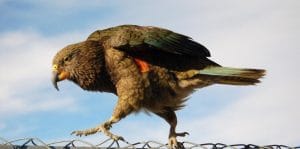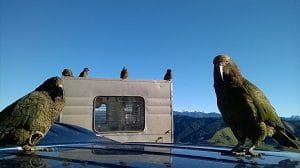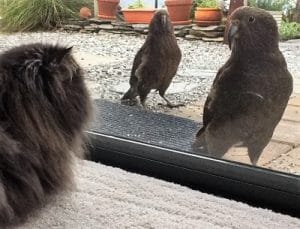What's the Conflicts Resolution programme all about?
On-going human–kea conflict is a challenge that is imperative to solve. Whilst there is conflict, there is the potential for negative perceptions of the species to be generated and retained and kea to be illegally killed. Kea are a fully protected species, endemic to the South Island of NZ and to harm or remove kea from an area without a permit, is illegal.

As such a proactive community-focused conflict response and resolution programme for kea has been developed and initiated. This project received funding mid 2014 and was initiated in the Motueka/Tasman/Nelson area. It has subsequently been rolled out across the South Island.
This project overall aims to identify the nature of conflict experienced by people living within kea habitat, provide ‘first response’ during conflict situations, help people deal proactively to prevent problem situations arising in the first instance and research practical methods of conflict resolution in collaboration and partnership with affected individuals, communities and DOC.

Do you have a problem with kea?
We recognise that curious kea can cause significant damage to human property. If you experience any problems which you need positive help and support solving, please contact Andrea Goodman (for the northern part of the South Island) or Tamsin Orr-Walker (southern part of the South Island). Conflict situations can be reported via our Conflicts Report Form or via our email.
You can also find useful information on kea proofing specific items (wiring, kayaks, solar panels, flashings, etc) by searching our kea proofing database.
And if you have any clever solutions to prevent kea damaging specific items, please enter your idea here! Thank you.
It is important to remember that many communities DO live CONFLICT-FREE with kea!
Useful Resources
As part of this programme we have developed a number of free resources to help people live in harmony with their wild (and sometimes challenging!) neighbours. If you wish to discuss any of these documents, please contact us anytime.

What is Human-Wildlife Conflict and how does this relate to kea?
Human-Wildlife conflict (HWC) is a growing global phenomena common to all areas where wildlife and human populations coexist and share limited resources. It “occurs when the needs and behavior of wildlife impact negatively on the goals of humans or when the goals of humans negatively impact the needs of wildlife." (Madden, 2004). It “is as much a conflict between humans and wildlife as it is a conflict between humans about wildlife (ibid)”.
Although conservation is one of NZ’s core activities, we are not exempt from experiencing HWC situations. Kea are often attracted to sites of human activity. Kea conflict with high country sheep farmers was first documented in the late 1860s (Marriner, 1908). Kea learned that sheep were a high-energy food source which, when snowbound, became easy targets for determined kea beaks. High sheep losses were attributed to kea and by the 1870’s a government bounty was initiated which resulted in an estimated 150,000 kea culled up until the early 1970's.
Today the perception of kea as destructive and a nuisance still persists. Changes in land use and increasing human activity and access into high country areas are resulting in kea coming into contact with more people and their property. For example, Fiordland National Park, one of NZ’s most pristine wilderness areas, and Arthur’s Pass, home to our most visible population of kea, host around 500,000 visitors annually (Statistics NZ, 2013). Property damage is reported each year by private landowners (including sheep farmers), tourists, tourist operators and workers and it is recognised that many more conflict events may go unreported.
Our Sponsors
- OneFortyOne Ltd (2019 -2023)
- Nelmac (2019 - 2021)
- Kim Klosterman (2017-2018)
- Cincinnati Zoo and Botanical Gardens (2014-2017)
- Department of Conservation
Programme outcomes
Year 4 (2017 - 2018)
As well as the usual conflict situations across the year, two of the KCTs Conflict Resolution team (Andrea and Tamsin) attended a 5-day workshop on conflict resolution in September 2017, run by The Centre for Conservation Peace Building (formerly Human-Wildlife Conflict Collaboration) in Washington DC. This intensive course was attended by over 20 people representing various species and ecosystems from around the world and aims to transform social conflict to create lasting solutions for people and wildlife. The information and learnings gathered during this course will be used to support the conflict transformation we do back in New Zealand for kea.
Year 3 (2016 - 2017)
At least 57 contacts were made (phone or email) to the Community Conflicts coordinator during the third reporting year of the project (September 2016 – August 2017 inclusive). Although this is up from previous years (12 in year 1 and 24 in year 2), no site visits were required as any issues were able to be resolved over the phone. This shows a steady decline in the number of site visits required (from 12 in year one to 10 in year two) and actual conflicts although contacts, people who simply want to discuss their concerns about potential issues, kea and 1080, ask for advice on ways to kea proof as well as just informing of kea visiting properties, is on the increase.
As in previous years, issues reported to date involved mild – wholesale destruction of property (business and personal) or nuisance value as follows:
- forestry equipment (vehicle seats, wiring, antennaes, rubber hosing etc) – on-going but being managed;
- transmission repeaters/transmitter wiring damage (Mt Campbell Communications and DOC);
- personal vehicles (any exposed rubber or wiring, seats on bikes etc);
- personal property (any soft or small items left outside);
- buildings (rubber seals, roof/chimney flashings, solar panel/aerial wiring, pipe lagging);
- external property (spa pool covers, individual plants, vege gardens etc);
- keeping people awake.
Although individual conflict situations seemed to be reduced there were a few serious issues which were worked through including a kea shooting in August 2016 at Takaha Hill (Golden Bay). The Conflicts Coordinator worked with DOC and police to a successful conviction in August 2017. This is only the second time a conviction for killing a kea has been successful so it is seen as a positive shift in the perception of kea by the courts and local communities. The KCT’s Conflicts Coordinator was involved in writing up impact reports, media reports and also organising community support (with corresponding impact reports written by local conservation groups and iwi) over the course of the past year. This has provided a great opportunity for local communities to discuss kea issues, to show their support for the species and to send a strong message that kea are important to protect.
Another notable development includes the development of Kea Guidelines for Plantation Forestry, to protect kea in forestry areas and to advise workers how to work around kea. This was developed by the Forestry Stewardship Council with the working group made up of forestry and KCT personnel and is seen as a landmark document for the protection of kea South Island wide.
In addition to this, discussions were initiated about possible changes to the Wildlife Act to make it an offence to feed kea. Feeding kea has been connected with human – kea conflict and the likelihood of kea picking up and ingesting poison (1080) baits and as such is seen to be a serious threat to the species survival.
Year 2 (2016 - 2016)
A total of 27 individual conflict events and/or requests for support were reported to the KCT in the second year of the project (1 July 2015 – end of August 2016) and 10 site visits conducted as a result. This is more than double the number reported in the 1st year (when 12 conflicts events were dealt with) and rather than indicate an increase in conflict events, appears that people are becoming increasingly aware of the project in affected local areas and are more prepared to come forward to report issues and seek help. Eleven of these reports have been from the Tasman region (St Arnaud, Murchison, Riwaka, Marahau, Tapawera, Motueka), six from the Golden Bay area (Takaka, Uruwhenua, Bainham, Ligar Bay and Tukurua), seven from the West Coast (Heaphy Track, Lake Kaniere, Taramakau, Haast, Hokitika, Franz and Fox Glaciers), and three from the Nelson/Marlborough areas (Nelson and Wairau Valley bordering the Tasman region). Eight of these were from forestry companies (including an alleged shooting), one from a ski field, three from businesses (cafes, guides and b&b’s), two from conservation related groups, one unknown and eight from private residents.
Twelve site visits were carried out (Rainbow ski field (Tasman), Murchison x 2 (Tasman), Franz Josef (West Coast), Fox Glacier (West Coast), Hokitika (West Coast), Takaka (Golden Bay), Riwaka x2 (Tasman), St Arnaud (Tasman), and Wairau Valley (Marlborough on the border of Tasman district).
At least 160 kea were implicated in the 27 complaints (some of these may be double counts as most kea are juvenile and un-banded and may be moving between sites).
Year 1 (2014 - 2015)
Since the start of the project (August 2014) a total of 12 conflicts situations were reported to the KCT (an additional 2 sites were visited prior to the start of the formal programme). Eight of these were in the Tasman area in the northern part of the South Island, two from Golden Bay, one on the West Coast and one in the Queenstown Lakes area. Six of these were from forestry companies, one from a Gun Club and four from private residents.
A total of 88 kea were implicated in the 12 complaints (some of these may be double counts as most kea were juvenile and unbanded and may be moving between sites).
All sites were visited and conflict assessed. Conflict involved mild to wholesale destruction of property (business and personal ) or nuisance value as follows:
- forestry equipment (vehicle seats, wiring, antennas, rubber hosing etc)
- personal vehicles (any exposed rubber or wiring, seats on bikes etc)
- personal property (any soft or small items left outside)
- buildings (rubber seals, roof/chimney flashings, solar panel/aerial wiring, pipe lagging, yurt coverings/gutters)
- external property (spa pool covers, individual plants, vege gardens etc)
- keeping people awake
Generic mitigation measures suggested to date include use of diversionary activity areas (in areas away from human habitation), use of bird electric fences (safe for kea), sprinklers, tarpaulins, bird repellents, netting as well as on-going education of complainants. The benefit of each of these methods is currently difficult to evaluate as kea are extremely mobile, and often visit conflict areas intermittently. Reason for absence is difficult to assess (ie other factors other than the mitigation method used may be contributing to kea not visiting the property). As such we do not know whether the methods used in each case have worked until we get a re-visitation and observations by the complainant can be made (ie objects are not damaged as a direct result of the mitigation method).

Research into potential mitigation measures has been undertaken where appropriate during the year. These include trialling of repellents, electric fencing, acoustic bird scarers and activity areas. To date, nothing has shown significant success in removing birds from conflict areas. Removal of food and other attractants (soft furnishings and other property which can be manipulated where possible) appears to be the best method of stopping destructive behaviour beginning in the first place.
Modifying wild kea behaviour has proven to be difficult. Kea are hardwired to be curious about new things in their environment and are destructive with the items they are able to manipulate. Resolving conflict is therefore largely about re-educating local communities about kea (status, numbers, uniqueness), kea behaviour (why they damage property, kea attractants, kea deterrents), and complainants' own behaviour and practices around kea. In some cases, this has resulted in a better understanding of the issues facing kea and the role of local communities in protecting those birds remaining.